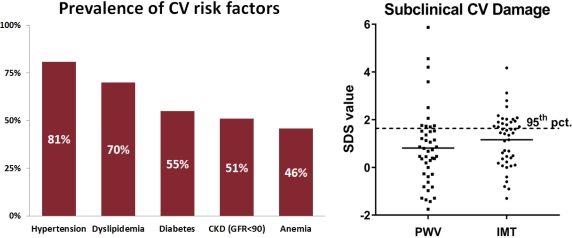Prevalence and Persistence of Cardiovascular Risk Factors and Subclinical Vascular Damage in Patients after Pediatric Lung Transplantation
1Pediatric Kidney, Liver and Metabolic Diseases, Hannover Medical School, Hannover, Germany
2Pediatric Pulmonology, Allergology and Neonatology, Hannover Medical School, Hannover, Germany.
Meeting: 2018 American Transplant Congress
Abstract number: C261
Keywords: Lung transplantation, Pediatric, Post-transplant hypertension, Vascular disease
Session Information
Session Name: Poster Session C: Lung: All Topics
Session Type: Poster Session
Date: Monday, June 4, 2018
Session Time: 6:00pm-7:00pm
 Presentation Time: 6:00pm-7:00pm
Presentation Time: 6:00pm-7:00pm
Location: Hall 4EF
In adults undergoing solid organ transplantation, cardiovascular (CV) disease causes a high level of morbidity and mortality. Children after lung transplantation (Lu-Tx) are prone to many CV risk factors, but whether they also suffer from subclinical CV damage was not reported yet. Our study therefore aimed to evaluate the prevalence of CV risk factors and subclinical CV damage in a large cohort of pediatric Lu-Tx recipients.
We assessed 47 pediatric Lu-Tx recipients (aged 5-18 yrs; 4.4±2.5 yrs after Lu-Tx) for CV risk factors (arterial hypertension; diabetes; dyslipidemia, defined as hypertriglyceridemia or reduced HDL-cholesterol; chronic kidney disease, CKD, defined as glomerular filtration rate (GFR) <90ml/min/1.73m2; anemia) and subclinical CV damage (pulse wave velocity, PWV for arterial stiffness; carotid intima media thickness, IMT for atherosclerosis). 35 and 23 patients have already had 1yr. and 2yr. follow-ups (F/U).
The prevalence of CV risk factors was high (see figure, left panel). Increased PWV- and IMT-SDS values were observed in 14% and 38% of children (see figure, right panel). Elevated PWV-SDS was significantly associated with higher diastolic blood pressure (r=0.355, p=0.019) and lower eGFR (r= -0.324, p=0.034). A longer time after Lu-Tx was significantly correlated with higher IMT-SDS values (r=0.352, p=0.018). In those patients with available F/U, we found that kidney function further detriorated.
Pediatric Lu-Tx recipients suffer from a high burden of CV risk factors that has already resulted in significant CV target organ damage. Our first F/U analyses also indicate that there is no resolution, but even progression of these risk factors highlighting the importance of evaluation of such comorbidities as part of post-transplant care.
CITATION INFORMATION: Onnen M., Memaran N., Borchert B., Blöte R., Sugianto R., Müller C., Melk A. Prevalence and Persistence of Cardiovascular Risk Factors and Subclinical Vascular Damage in Patients after Pediatric Lung Transplantation Am J Transplant. 2017;17 (suppl 3).
To cite this abstract in AMA style:
Onnen M, Memaran N, Borchert B, Blöte R, Sugianto R, Müller C, Melk A. Prevalence and Persistence of Cardiovascular Risk Factors and Subclinical Vascular Damage in Patients after Pediatric Lung Transplantation [abstract]. https://atcmeetingabstracts.com/abstract/prevalence-and-persistence-of-cardiovascular-risk-factors-and-subclinical-vascular-damage-in-patients-after-pediatric-lung-transplantation/. Accessed December 25, 2025.« Back to 2018 American Transplant Congress
